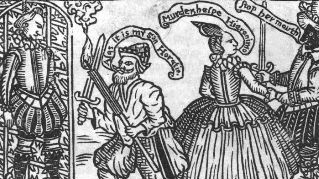His Living Hue: What Did Shakespeare Look Like?

“Why should false painting imitate his cheek/ And steal dead seeing of his living hue?” William Shakespeare wrote in Sonnet 67, which begins, “Ah! wherefore with infection should he live.” Since flights of angels sang him to his rest in 1616, Shakespeare’s likeness has been “infected” with the question of what portraits are truly of him and which are truly not. Everyone who has trudged through Romeo and Juliet in high school most likely knows the engraved portrait that appeared on the First Folio of Shakespeare’s works in 1623, known in Shakespearean circles as The Droeshout Portrait after its maker, Martin Droeshout. But Droeshout never met Shakespeare in the flesh, perhaps relying on an earlier portrait and/or the descriptions from memory of friends of the Bard such as fellow poet-playwright Ben Jonson, who gave his stamp of approval to the likeness in the introductory poem to the First Folio. “O, could he but have drawne his wit/ As well in brasse, as he hath hit/ His face,” Jonson says of Droeshout’s attempt at Shakespeare’s likeness. And yet, we still wonder whether this captures the Bard’s “living hue.”
Jonson was a kidder, a rapier-tongued wit overshadowed only by a contemporary (and friend) who may have been the greatest practitioner of the English language ever, and another kidder on the grandest scale. As Adam Gopnik previously suggested, depicting Shakespeare as moon-faced and severely balding may have been a true depiction, or it may have been a grand deception—one last joke played by an incurable prankster on a kindred spirit for posterity. Shakespeare would have gotten the joke better than anyone. Will would have wanted it that way, Jonson may have said to himself as he penned the poem that sealed the deal.
The Chandos Portrait held the title for many years of being the only portrait of Shakespeare done from life, or at least during the writer’s lifetime. Droeshout may have referred to Chandos when doing his engraving. Alas, we don’t know who painted Chandos. Again, most of the testimony that it’s a faithful depiction comes from, as you would guess, Ben Jonson and other friends of Shakespeare who may have shared a similar sense of humor, perhaps making the entire history of Shakespeare portraiture one grand practical joke on posterity. Scholars believe that the painting was changed at some point (the hair made longer and the beard more pointed), but don’t know why. Did someone deface the portrait as a joke? Did someone want to make Shakespeare look more like the “Shakespeare” people expected? Or is this someone else made to look Shakespearean? Did Droeshout refer to Chandos or was it the other way around? We simply don’t know.
In the exhibition The Changing Face of William Shakespeare, which runs at The Morgan Library & Museum through May 1, 2011, a new contender for the title takes center stage. The Cobbe Portrait (detail shown) sprung upon the Shakespearean scene in 2009, when the Shakespeare Birthplace Trust in Stratford-upon-Avon unveiled the previously unknown portrait. The Cobbe resided for centuries in the Irish country house of the Cobbe family beginning with Archbishop Charles Cobbe, who inherited the painting from Henry Wriothesley, 3rd Earl of Southampton and, most importantly, Shakespeare’s patron. Resemblances to Droeshout’s depiction (again!) and a Latin inscription from Horace addressed to a playwright add weight to the claim. The Cobbe certainly has more hair, perhaps being a portrait of the artist as a young man (or younger than the Droeshout), but doesn’t look Shakespearean to modern eyes conditioned to expect the Droeshout’s balding pate. The argument goes round and round. Are we being deceived or informed? Will would have wanted it this way. Or would he?
Over 60 portraits claiming to be of Shakespeare were offered for sale to the National Portrait Gallery in London in the second half of the nineteenth century alone. Their website collects 42 images of Shakespeare in their collection, including the Chandos. The long history of strong contenders, wild guesses, and outright frauds stretches across the centuries. “Counterfeit? I lie, I am no counterfeit: to die,/ is to be a counterfeit,” Falstaff says in Henry IV, Part I (V, 4, ll. 3081-3086), “for he is but the/ counterfeit of a man who hath not the life of a man:/ but to counterfeit dying, when a man thereby/ liveth, is to be no counterfeit, but the true and/ perfect image of life indeed.” Maybe Falstaff is right. Maybe we should stop looking for Shakespeare in dead paintings and go back to the words (the wit Jonson alludes to in his poem) to see the true, living “face” of Shakespeare. Of course, Falstaff is a joker, too, and the words in his mouth are put there by Shakespeare. That is, if Shakespeare wrote them.
[Image: Artist Unknown, Seventeenth Century (c.1610). William Shakespeare. (detail) Oil on panel, 24 ¼ x 14 ¾ inches (53.9 x 37.5 cm). Collection of Archbishop Charles Cobbe (1686–1765), Cobbe Collection.]
[Many thanks to The Morgan Library & Museum for providing me with the image above and other press materials from their exhibition The Changing Face of William Shakespeare, which runs through May 1, 2011.]





